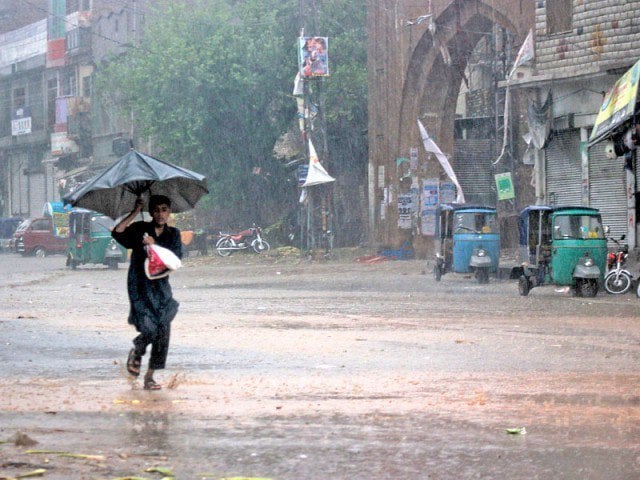Title: K-P, Balochistan battle historical rains, storms and floods
Share:
Linkedin
Whatsapp
Facebook
 Description:
Description:
As Balochistan reeled from devastating floods, it braced for another wet spell, starting Thursday (today), which could bring heavy downpours accompanied by thunderstorms and hailstorms, according to the National Disaster Management Authority (NDMA) on Wednesday.
Overall at least 65 people have died in rain-related incidents, including 28 killed in lightning strikes, across the country, according to the media reports, with rain so far in April falling at nearly twice the historical average rate for the month.
The largest death toll was in Khyber-Pakhtunkhwa (K-P), where 32 people have died, including 15 children, and more than 1,300 homes have been damaged. Nearly, two-dozen people, including farmers harvesting wheat, were killed by lightning in Punjab, the reports said.
In Balochistan, recent heavy rainfall unleashed devastating flash floods across the province's coastal belt, wreaking havoc in Gwadar, Pasni, and other areas. Gwadar bore the brunt of the onslaught, with nearly all public and private buildings submerged under the deluge.
In Pasni and surrounding regions, communities found themselves grappling with the catastrophic aftermath of the floods. The floods spared neither schools nor homes, leaving education institutions submerged and countless residences damaged.
Pictures posted on social media depict individuals wading through waist-deep waters, desperately trying to salvage their belongings amid chaos. Tragically, the death toll from the disaster also climbed, which rose to nine fatalities so far.
Balochistan government spokesperson Shahid Rind confirmed the grim statistics of nine dead and another nine injured, highlighting the enormity of the situation. The government has declared a state of emergency, mobilising resources to aid affected communities.
However, the scale of destruction is staggering, with 40 homes completely destroyed and 80 others partially damaged by the ferocious downpour. The floods also wreaked havoc with infrastructure, leaving roads and highways impassable, thus disrupting traffic and communication networks.
The true extent of the damage will become evident, once the water recedes. Currently, efforts are under way to provide relief and support to those impacted by the calamity, emphasising the urgent need for solidarity in the face of nature's fury.
K-P and Punjab
Ten more people, including nine children, died on Tuesday in various parts of K-P in the aftermath of the torrential rains as the provincial government imposed an emergency in 13 districts for the provision of relief and restoration of damaged communication networks and water supply.
“All the casualties [in K-P] resulted from the collapse of walls and roofs,” Anwar Khan, spokesman for the Provincial Disaster Management Authority (PDMA), told AFP on Wednesday. Villagers were forced to seek refuge on higher ground, including on the shoulders of motorways.
“In April, we have observed highly unusual rainfall patterns,” Zaheer Babar, spokesperson for the Pakistan Meteorological Department, told AFP. “Climate change is a major factor behind these unusual weather patterns and above normal rainfalls,” he added.
Most of the country experienced a pause in rain on Tuesday and Wednesday, but more downpours are predicted in the coming days. “From April 1st to April 17th, we experienced precipitation levels exceeding the historical average by 99%,” Babar said, citing data from the past 30 years as a comparison.
Amid a grim situation in the province, the NDMA in its latest advisory warned of a series of moderate to intense weather systems causing rainfall and thunderstorms from April 17 to 29, citing the latest projections from the National Emergency Operations Centre (NEOC).
The forecast indicated that the latest weather system would bring heavy rainfall and thunderstorms, lasting until April 22 – in Balochistan from April 17-19, in Punjab and Sindh from April 18-19. The advisory stated that upper Punjab would experience the effects from April 18-21.
K-P, Gilgit-Baltistan (G-B), and Azad Jammu and Kashmir (AJK) will also be affected from April 17 to 22,” the advisory said, adding that a weaker weather system was expected to enter Pakistan on April 23, bringing low rainfall and thunderstorms till April 24.
According to the NDMA, Balochistan and upper Punjab would experience slight impacts from April 23-24 weather system, but K-P, G-B, and AJK would be affected. However, Sindh was not expected to be impacted during this period, it added.
Then, a strong weather system was forecast to enter Pakistan on April 25, bringing heavy rain, thunderstorms, and hailstorms with occasional gaps until April 29. “This system will affect Balochistan from April 25 to April 29, with intermittent gaps,” the NDMA said.
“Sindh will experience impacts on April 25, 26, and 28, while South Punjab will be affected from April 27-28. Upper Punjab will face the impact from April 26 to 29, while K-P will experience effects from 25 to 29, potentially. G-B and AJK would also be impacted from April 25 to 29.
The expected rainfall might trigger flash floods in local nullahs of vulnerable areas, including Khuzdar, Ziarat, Zhob, Sherani, Muslim Bagh, Quetta, Pishin, Kech, Panjgur, Gwadar, and Turbat. Flooding might also occur in low-lying areas during the forecast period, particularly in south-western Balochistan.
In the light of these projections, the NDMA has issued instructions for the Provincial Disaster Management Authorities (PDMAs), District Disaster Management Authorities (DDMAs), and other relevant line departments to remain vigilant and prepared to respond to any emergent situations.
(WITH INPUTS FROM AGENCIES)
Published Date: 18-Apr-2024
Share:
Linkedin
Whatsapp
Facebook
